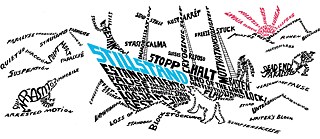Photography
Standstill in History
Photographs disrupt the flow of history like a dam, bringing the linear progress of things to a standstill. They circle in place, remaining for posterity: Marilyn Monroe or the moon landing, available for all eternity.
Even before the invention of the phonograph, photography was the first indexical recording system. The term indexicality was coined by the American philosopher Charles Sanders Peirce back in 1893. Indices, he wrote, are signs that “show something about things, on account of their being physically connected with them.” Smoke from a fire, for example, or footprints in the sand are signs that signify what caused them.
Because photography, or at least analog photography, is indexical, photo theorists have been chiefly concerned with the photograph as a medium of representation, that is, with the relationship between the picture and what it depicts, between signs and the objects they signify. This has given rise to another preoccupation of photo theorists, namely time: specifically, the complex relationships between the frozen moment and transience, between personal and collective memory, and between stasis and history. These are central themes in the reflections — or rather the melancholy meditations — of some of the most interesting photo theorists, including Walter Benjamin, Roland Barthes, and Susan Sontag.
In his reflections on an 1865 photograph of a young man on death row, Barthes explores the paradox of photographic observation:
I read at the same time: This will be, and this has been; I observe with horror an anterior future in which death is the stake. By giving me the absolute past of the pose [...], the photograph tells me of death in the future. What pricks me is the discovery of this equivalence. In front of the photograph of my mother as a child, I tell myself: She is going to die: I shudder [...] over a catastrophe, which has already occurred.
While for Barthes the photograph is a memento mori of anticipated mourning (“this is how it will have been”), Vilém Flusser, a Czech-Brazilian phenomenologist of communication, is primarily interested in the disruption that photography inflicts on our perception of a linearly ordered course of history, a perception informed by the written word: technical images like the photograph dam up the flow of history, bringing the linear progress of things to a standstill. Photographs are not directed. They circle in place, remaining endlessly available for posterity. We can behold Marilyn Monroe or the moon landing forever. Technical images distill dramatic events into motionless scenes: natures mortes, still lifes. Likewise, tableaux vivants simulate death in immobility.
By means of this effect, as well as its origins in formal mathematical thought, the photograph can be considered the first post-historical image:
Certainly, the photograph has succeeded in carrying the image into history; but, in doing so, it has interrupted the stream of history. Photographs are dams placed in the way of the stream of history, jamming historical happenings. Thus, the photograph can be considered the first post-historical image. (Flusser, 2002)
We’re all going to die, to be sure, but we can all leave traces behind, ideally images or writings, that enable us to live on forever in stillness even after we’re gone: “In his futile struggle against death, man buries information in objects in order to store them in the cultural memory. Culture is a memory in which man hides from oblivion.” (Flusser, 1993) He places his hope, one might add, in standstill.
---------------------------------------------------------------------------------
– Friedrich Kittler, Aufschreibesysteme 1800/1900, Munich 1985
– Friedrich Kittler, Grammophon Film Typewriter, Berlin 1986
– Charles Sanders Peirce, “Die Kunst des Räsonierens,” in: Bernd Stiegler (ed.) Texte zur Theorie der Fotografie, Stuttgart 2010, p. 7
– Roland Barthes, Die helle Kammer. Bemerkungen zur Photographie, Frankfurt 1989, p. 106
– Vilém Flusser, “Photography and History,” in: Andreas Ströhl (ed.), Flusser: Writings, Minneapolis and London 2002, p. 128
– Vilém Flusser, “Umbruch der menschlichen Beziehungen?”, in: Stefan Bollmann and Edith Flusser (eds.), Flusser: Kommunikologie, Mannheim 1996, p. 16
– Vilém Flusser, “Gespräch, Gerede, Kitsch. Zum Problem des unvollkommenen Informationskonsums,” in: Vilém Flusser, Nachgeschichte. Eine korrigierte Geschichtsschreibung, Bensheim and Düsseldorf 1993, p. 226 ff.






